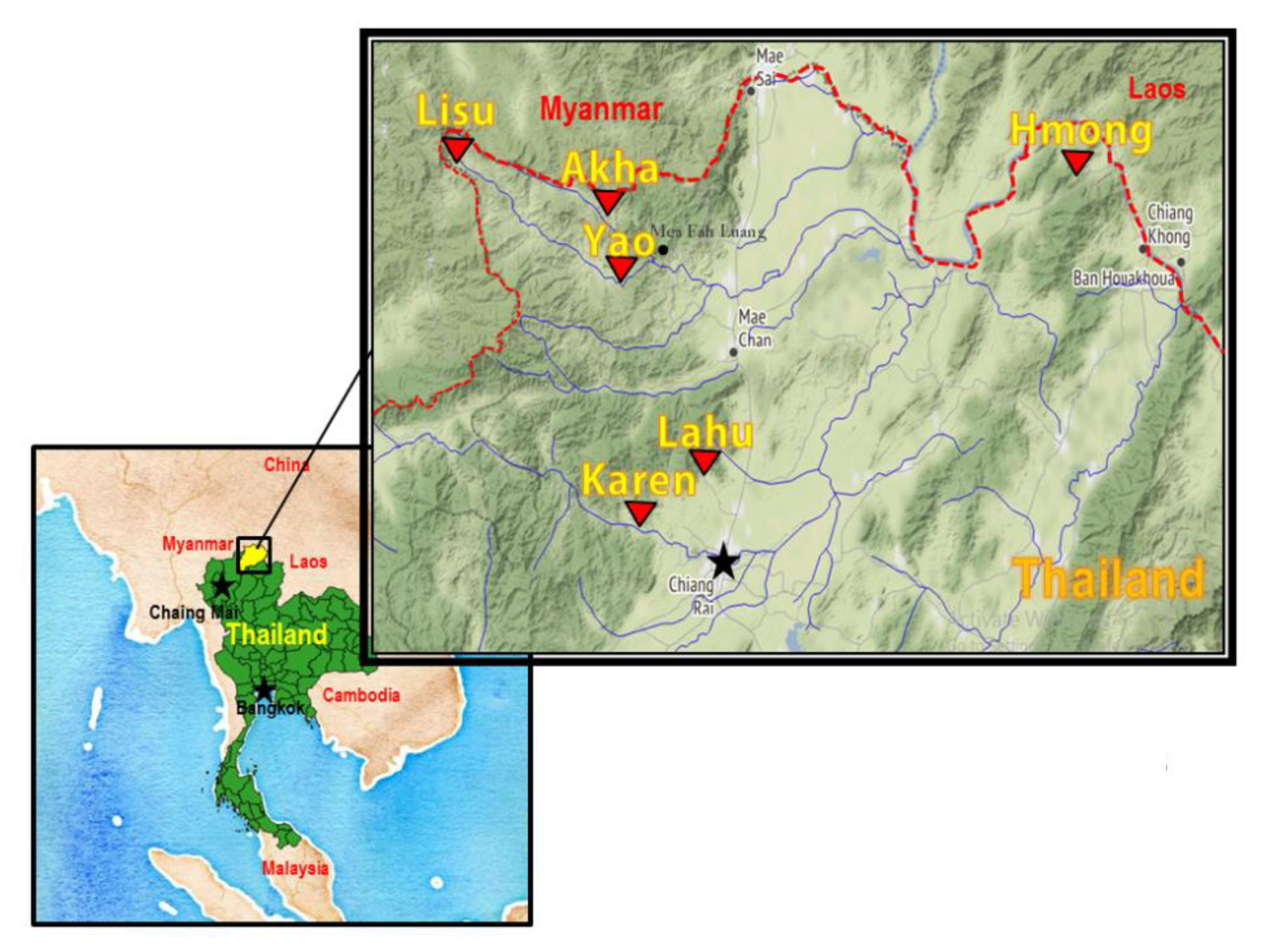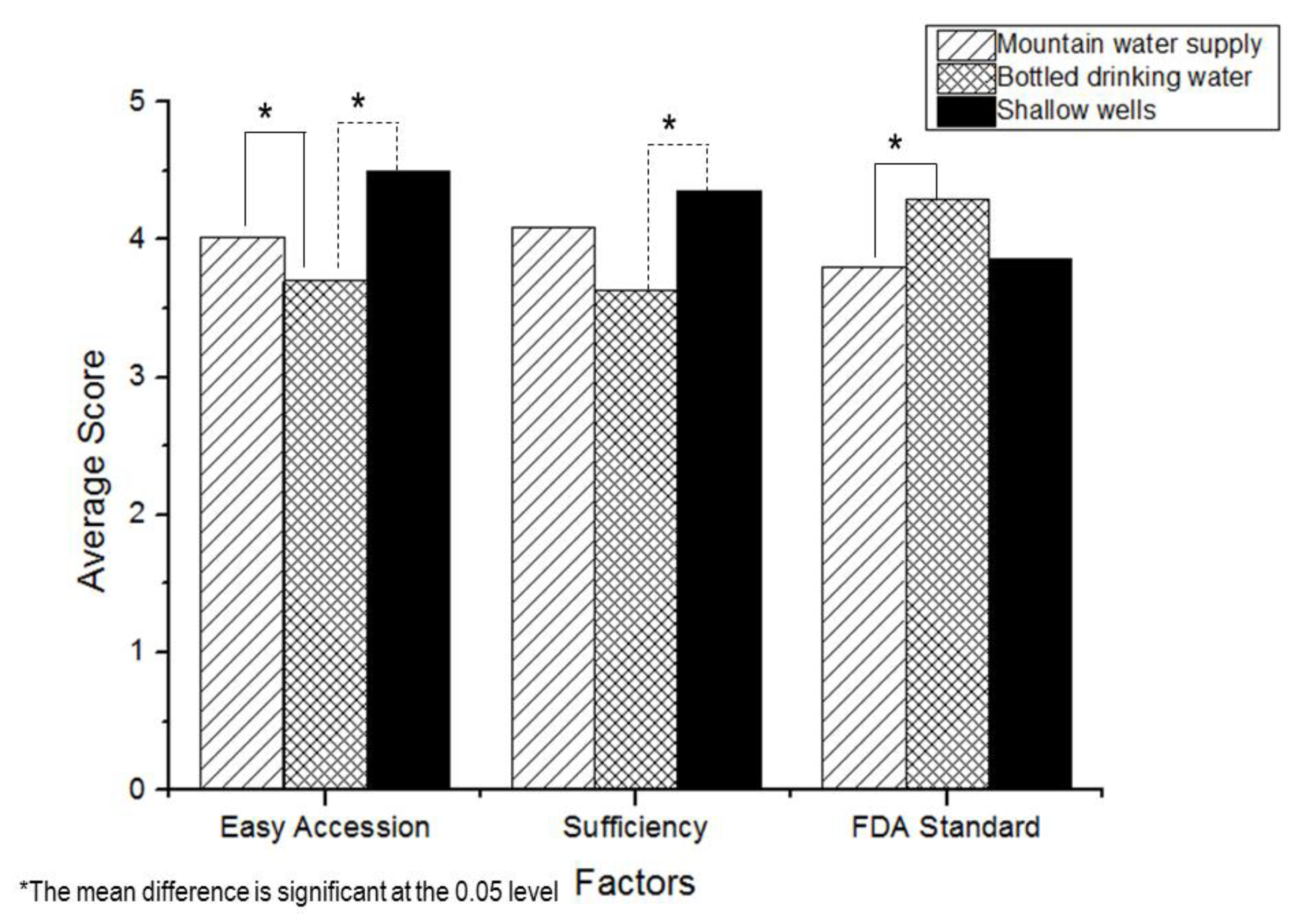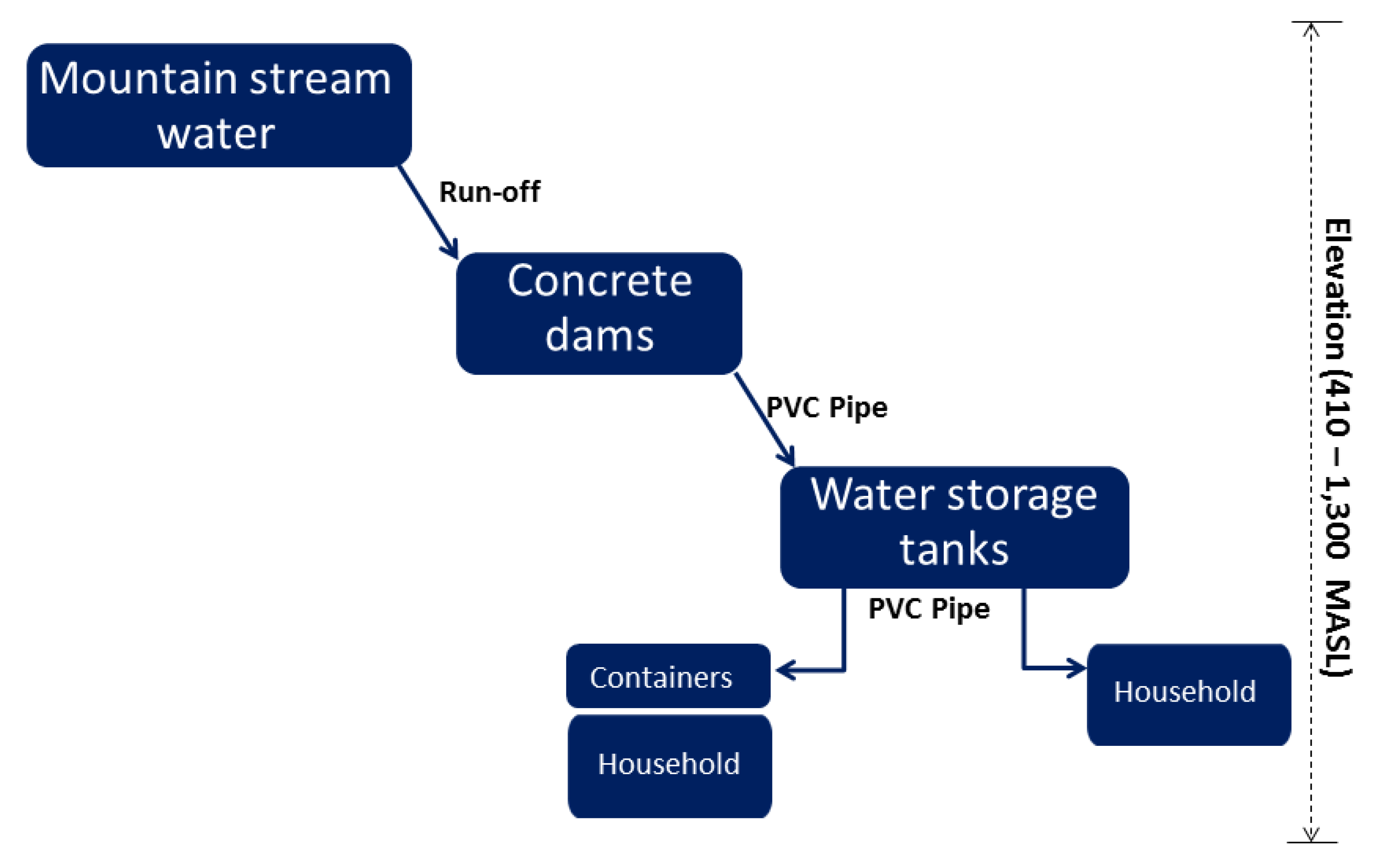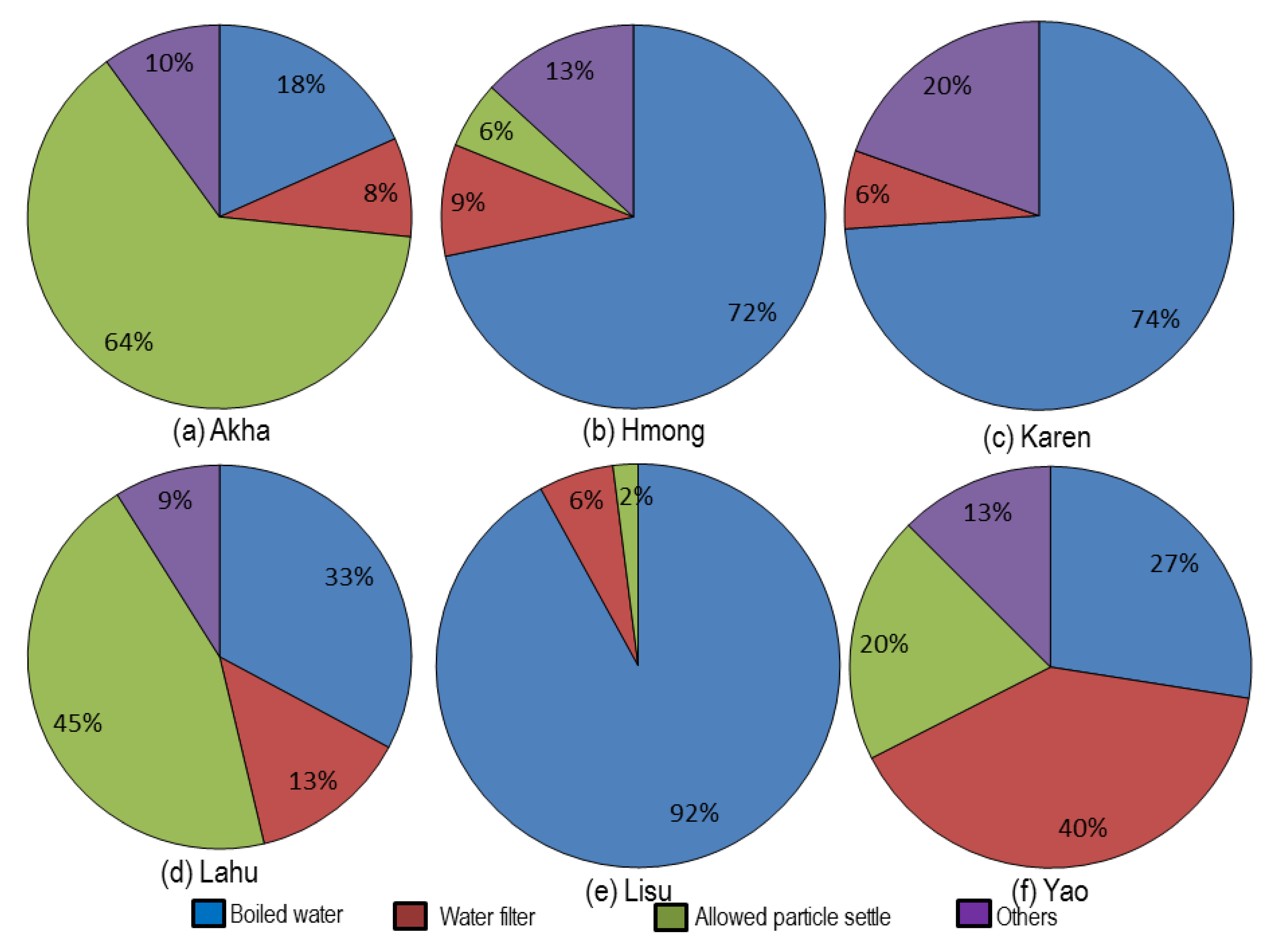Drinking Water Investigation of Hill Tribes: A Case Study in Northern Thailand
Abstract
1. Introduction
2. Materials and Methods
2.1. Study Sites
2.2. Household Survey and Water Sampling
2.3. Statistical Analysis
3. Results and Discussions
3.1. The Participnats’ Profiles
3.2. Sources of Drinking Water
3.3. Influencing Factors for Some Selcted Sources of Drinking Water of the Hill Tribe People
3.4. Mountain Water Supply Management
3.5. Houshold Water Storage Containers
3.6. Post-Treatment of Drinking Water
3.7. Drinking Water Quality
4. Conclusions
Author Contributions
Funding
Acknowledgments
Conflicts of Interest
References
- United Nations (UN). Global Issues: Water. Available online: https://www.un.org/en/sections/issues-depth/water/ (accessed on 18 October 2019).
- WHO. Drinking Water: Key Facts. Available online: https://www.who.int/news-room/fact-sheets/detail/drinking-water (accessed on 18 October 2019).
- Cassivi, A.; Guilherme, S.; Bain, R.; Tilley, E.; Waygood, E.O.D.; Dorea, C. Drinking water accessibility and quantity in low and middle-income countries: A systematic review. Int. J. Hyg. Environ. Health 2019, 222, 1011–1020. [Google Scholar] [CrossRef] [PubMed]
- WHO. Drinking Water Quality in the South-East Asia Region, Indraprastha Estate, Mahatma Gandhi Marg, New Delhi. Available online: https://apps.who.int/iris/handle/10665/204999 (accessed on 25 January 2020).
- CDC. Global Diarrhea Burden, Diarrhea: Common Illness, Global Killer. 2019. Available online: https://www.cdc.gov/healthywater/global/diarrhea-burden.html (accessed on 18 October 2019).
- Okullo, J.O.; Moturi, W.N.; Ogendi, G.M. Open defaecation and its effects on the bacteriological quality of drinking water sources in Isiolo County, Kenya. Environ. Health Insights 2017, 11. [Google Scholar] [CrossRef] [PubMed]
- Khana, S.; Shahnaz, M.; Jehan, N.; Rehmana, S.; Shah, M.T.; Din, I. Drinking water quality and human health risk in Charsadda district, Pakistan. J. Clean. Prod. 2013, 60, 93–101. [Google Scholar] [CrossRef]
- MOPH. Annual Epidemiology Surveillance Report 2015. Dep. Dis. Minist. Public Health Thail. 2015, 1, 121–123. [Google Scholar]
- Luksamijarulkul, P.; Tongpradit, S.; Vatanasomboon, P.; Utrarachkij, F. Sero-epidemiological study of hepatitis a virus infection among hill-tribe youth and household environmental sanitation, a hill-tribe community in northern Thailand. Southeast Asian J. Trop. Med. Public Health 2003, 34, 569–576. [Google Scholar] [PubMed]
- Phanwong, S.; Kamsrisuk, S.; Chaichan, B.; Kamla, W.; Chaiwanna, R.; Pongsuparp, N. An outbreak of viral hepatitis A in Wiangpapao District, Chiang Rai Province, 2005. J. Health Syst. Res. 2008, 2, 76–81. [Google Scholar]
- Apidechkul, T. Prevalence and risk factors of intestinal parasitic infections among hill tribe schoolchildren, Northern Thailand. Asian Pac. J. Trop. Dis. 2015, 59, 695–699. [Google Scholar] [CrossRef]
- WHO. Guidelines for Drinking-Water Quality, 4th ed.; WHO Graphics: Geneva, Switzerland, 2011. [Google Scholar]
- Barbar, R.W.; Evans, B.; Hunter, P.R.; Bartram, J. On-plot drinking water supplies and health: A systematic review. Int. J. Hyg. Environ. Health 2016, 219, 317–330. [Google Scholar] [CrossRef]
- Viessman, W.; Hammer, M.J. Water Supply and Pollution Control, 6th ed.; Prentice Hall: Upper Saddle River, NJ, USA, 1988. [Google Scholar]
- MWA, (Metropolitan Waterworks Authority). Water Supply Process. Available online: https://www.mwa.co.th/main.php?filename=treat_water (accessed on 18 October 2019). (In Thai).
- PWA, (Provincial Waterworks Authority). Producing of Water Supply. 2019. Available online: https://reg5.pwa.co.th/km/index.php/2018-09-11-02-52-23/16-menufacture-pwa (accessed on 18 October 2019). (In Thai).
- The Hill Tribe Welfare and Development Center, Chiang Rai Province. Hill Tribe Population 2013; The Hill Tribe Welfare and Development Center, Ministry of Interior: Chiang Rai, Thailand, 2013; pp. 14–27. (In Thai) [Google Scholar]
- Princess Maha Chakri Siridhorn Anthropology Center. Hill Tribe; Bangkok, Thailand, 2012. Available online: https://www.sac.or.th/main/en (accessed on 18 October 2019). (In Thai).
- Turner, R.C.; Carlson, L. Indexes of Item-Objective Congruence for Multidimensional Items. J. Int. J. Test. 2003, 3, 2. [Google Scholar] [CrossRef]
- APHA. Standard Methods for the Examination of Water and Wastewater, 23th ed.; 9221 B and 9221 E; American Public Health Association: Washington, DC, USA; American Water, Works, Association: Denver, CO, USA; Water Environment Federation: Alexandria, VA, USA, 2017. [Google Scholar]
- Gurung, A.; Adhikari, S.; Chauhan, R.; Thakuri, S.; Nakarmi, S.; Ghale, S. Water crises in a water-rich country: Case studies from rural watersheds of Nepal’s mid-hills. Water Policy Lond. IWA Publ. 2019, 21, 833. [Google Scholar] [CrossRef]
- Hu, Z.; Morton, L.W.; Mahler, R.L. Bottled Water: United States consumers and their perceptions of water quality. Int. J. Environ. Res. Public Health 2011, 8, 565–578. [Google Scholar] [CrossRef] [PubMed]
- National Water Quality Management Strategy. Australian Drinking Water Guideline 6 20II Version 3.5 Update August 2018 Australian Government; Australian Government, National Health and Medical Research Council, National Resource Management Council: Canberra, Australia, 2018.
- Government Publishing Office (US). Bottled Water. Available online: https://www.ecfr.gov/cgibin/textidx?SID=a345042f6bd438d7949b0270596b60fd&mc=true&node=se21.2.165_1110&rgn=div8 (accessed on 20 October 2019).
- Silvey, J.K.G.; Roach, A.W. Studies on microbiotic cycles in surface waters. J. AWWA 1964, 56, 60–72. [Google Scholar] [CrossRef]
- Liniger, H.; Weingartner, R. Mountains and Freshwater Supply. Available online: http://www.fao.org/3/w9300e/w9300e08.htm (accessed on 20 October 2019).
- Gilman, R.H.; Skillicorn, P. Boiling of drinking-water: Can a fuel-scarce community afford it? Bull. World Health Organ. 1985, 63, 157–163. [Google Scholar] [PubMed]
- Rosa, G.; Miller, L.; Clasen, T. Microbiological effectiveness of disinfecting water by boiling in rural Guatemala. Am. J. Trop. Med. Hyg. 2010, 82, 473–477. [Google Scholar] [CrossRef] [PubMed]
- Anantaphruti, M.T.; Waikakul, J.; Maipanich, W.; Nuamtanong, S.; Pubampen, S. Soil-transmitted helminthiases and health behavior among schoolchildren and community members in a west-central border area of Thailand. Southeast Asian J. Trop. Med. Public Health 2004, 35, 260–266. [Google Scholar] [PubMed]
- Shevasant, S.; Sujumnonk, P.; Stoeckel, J. Determinants of “Risk Factors” Associated with Infant and Child Morbidity and Mortality among the Karen Hilltribe Population of Northern Thailand. 1987. Available online: https://www.popline.org/node/347954 (accessed on 18 October 2019).
- Logsdon, G.S. Microbiology and drinking water filtration. In Drinking Water Microbiology; McFeters, G.A., Ed.; Springer: New York, NY, USA, 1990; pp. 120–146. [Google Scholar]
- Department of Health, Thailand. Standard of Drinking Water from Water Supply System 2010. Available online: http://foodsan.anamai.moph.go.th/more_news.php?cid=87&filename=index (accessed on 20 October 2019). (In Thai)
- Sammarraee, M.A.; Chan, A. Large-eddy simulations of particle sedimentation in a longitudinal sedimentation basin of a water treatment plant. Part 2: The effects of baffles. Chem. Eng. J. 2009, 152, 3315–3321. [Google Scholar] [CrossRef]
- An, Y.J.; Breindenbach, G.P. Monitoring E. coli and total coliforms in natural spring water as related to recreational mountain areas. Environ. Monit. 2005, 102, 131–137. [Google Scholar] [CrossRef] [PubMed]
- Rai, S.K.; Ono, K.; Yanagida, J.I.; Kurokawa, M.; Rai, C.K. Status of drinking water contamination in Mountain Region, Nepal. Nepal Med. Coll. J. 2009, 11, 281–283. [Google Scholar] [PubMed]
- Pant, N.D.; Poudyal, N.; Bhattacharya, S.K. Bacteriological quality of bottled drinking water versus municipal tap water in Dharan municipality, Nepal. J. Health Popul. Nutr. 2016, 35, 17. [Google Scholar] [CrossRef] [PubMed]
- Clasen, T.; McLaughlin, C.; Nayaar, N.; Boisson, S.; Gupta, R.; Desai, D.; Shah, N. Microbiological effectiveness and cost of disinfecting water by boiling in semi-urban India. Am. Soc. Trop. Med. Hyg. 2008, 79, 407–413. [Google Scholar] [CrossRef]





| No | Variable | Total Number of Respondent (n = 425) (%) | Number of Respondent (% of Each Tribe) | |||||
|---|---|---|---|---|---|---|---|---|
| Akha (n = 79) | Hmong (n = 55) | Karen (n = 80) | Lahu (n = 79) | Lisu (n = 57) | Yao (n = 75) | |||
| 1 | Gender | |||||||
| Male | 190 (44.7 %) | 34 (43.0%) | 41 (74.5%) | 33 (41.3%) | 33 (41.8%) | 24 (42.1%) | 25 (33.3%) | |
| Female | 235 (55.3%) | 45 (57.0%) | 14 (25.5%) | 47 (58.8%) | 46 (58.2%) | 33 (57.9%) | 50 (66.7%) | |
| 2 | Education | |||||||
| Primary or below | 329 (77.4%) | 69 (87.3%) | 38 (69.1%) | 50 (62.5%) | 58 (73.4%) | 54 (94.7%) | 60 (80.0%) | |
| Secondary and Tertiary | 86 (20.2%) | 10 (12.7%) | 17 (30.9%) | 23 (28.8%) | 21 (26.6%) | 3 (5.3%) | 12 (16.0%) | |
| Bachelor degree | 10 (2.4%) | 0 (0%) | 0 (0%) | 7 (8.8%) | 0 (0%) | 0 (0%) | 3 (4.0 %) | |
| 3 | Occupation | |||||||
| Agriculture | 266 (62.6%) | 56 (70.9%) | 51 (92.7%) | 45 (56.3%) | 12 (15.2%) | 53 (93.0%) | 49 (65.3%) | |
| Undergraduate student | 2 (0.5%) | 1 (1.3%) | 0 (0%) | 0 (0%) | 0 (0%) | 0 (0%) | 1 (1.3%) | |
| Government officer | 4 (0.9%) | 1 (1.3%) | 1 (1.8%) | 1 (1.3%) | 0 (0%) | 0 (0%) | 1 (1.3%) | |
| Private business | 2 (0.5%) | 0 (0%) | 0 (0%) | 2 (2.5%) | 0 (0%) | 0 (0%) | 0 (0%) | |
| Housewife | 11 (2.6%) | 0 (0%) | 0 (0%) | 5 (6.3%) | 2 (2.5%) | 0 (0%) | 4 (5.3%) | |
| Freelance | 110 (25.9%) | 21 (26.6%) | 1 (1.8%) | 19 (23.8%) | 57 (72.2%) | 1 (1.8%) | 11 (14.7%) | |
| Merchant | 8 (1.9%) | 0 (0%) | 1 (1.8%) | 2 (2.5%) | 2 (2.5%) | 0 (0%) | 3 (4.0%) | |
| Private company | 2 (0.5%) | 0 (0%) | 1 (1.8%) | 0 (0%) | 1 (1.3%) | 0 (0%) | 0 (0%) | |
| Others | 20 (4.7%) | 0 (0%) | 0 (0%) | 6 (7.5%) | 5 (6.3%) | 3 (5.3%) | 6 (8.0%) | |
| 4 | Income (baht/month) | |||||||
| <5000 | 253 (59.5%) | 53 (67.1%) | 36 (65.5%) | 40 (50.0%) | 30 (38.0%) | 51 (89.5%) | 43 (57.3%) | |
| 5001–10,000 | 125 (29.4%) | 19 (24.1%) | 15 (27.3%) | 31 (38.8%) | 36 (45.6%) | 6 (10.5%) | 18 (24.0%) | |
| 10,001–15,000 | 24 (5.7%) | 3 (3.8%) | 1 (1.8%) | 7 (8.8%) | 11 (13.9%) | 0 (0%) | 2 (2.7%) | |
| 15,001–20,000 | 4 (0.9%) | 1 (1.3%) | 1 (1.8%) | 0 (0%) | 2 (2.5%) | 0 (0%) | 0 (0%) | |
| 20,001–25,000 | 6 (1.4%) | 2 (2.5%) | 1 (1.8%) | 1 (1.3%) | 0 (0%) | 0 (0%) | 2 (2.7%) | |
| >25,000 | 13 (3.6%) | 1 (1.3%) | 1 (1.8%) | 1 (1.3%) | 0 (0%) | 0 (0%) | 10 (13.3%) | |
| Factors | Tribes (Max = 5) | F-Test p-Value | |||||||||||
|---|---|---|---|---|---|---|---|---|---|---|---|---|---|
| Akha (n = 79) | Hmong (n = 55) | Karen (n = 80) | Lahu (n = 79) | Lisu (n = 57) | Yao (n = 75) | ||||||||
| Mean (SD) | Mean (SD) | Mean (SD) | Mean (SD) | Mean (SD) | Mean (SD) | ||||||||
| Colorless or clear | 4.0 | (0.9) | 4.6 | (0.6) | 4.7 | (0.7) | 4.7 | (0.6) | 3.9 | (0.5) | 4.7 | (0.6) | * 0.000 |
| No taste | 3.4 | (1.2) | 3.7 | (1.1) | 4.3 | (1.1) | 4.0 | (1.2) | 4.8 | (0.4) | 3.4 | (1.2) | * 0.000 |
| No odor | 3.6 | (1.0) | 4.2 | (0.9) | 4.7 | (0.7) | 4.6 | (0.9) | 4.7 | (0.7) | 4.9 | (3.2) | * 0.000 |
| Low cost | 3.9 | (1.0) | 4.0 | (1.0) | 4.6 | (0.9) | 4.4 | (0.9) | 4.0 | (0.3) | 2.5 | (1.3) | * 0.000 |
| Disinfection process | 3.4 | (1.0) | 3.9 | (1.2) | 4.4 | (0.9) | 4.4 | (1.0) | 4.0 | (0.3) | 4.1 | (1.0) | * 0.000 |
| Easy access | 3.6 | (0.9) | 3.8 | (1.1) | 4.4 | (0.9) | 4.1 | (1.1) | 4.8 | (0.4) | 3.3 | (1.0) | * 0.000 |
| Sufficiency | 3.6 | (0.8) | 3.5 | (1.0) | 4.2 | (1.1) | 4.5 | (0.8) | 4.9 | (0.4) | 3.4 | (1.0) | * 0.000 |
| Health safety | 3.9 | (0.9) | 4.2 | (0.9) | 4.7 | (0.7) | 4.8 | (0.5) | 4.9 | (0.3) | 3.9 | (1.0) | * 0.000 |
| FDA standard a | 3.1 | (1.1) | 3.7 | (1.2) | 4.6 | (0.8) | 4.7 | (0.8) | 3.1 | (0.3) | 3.9 | (0.9) | * 0.000 |
| Advertisement | 2.8 | (1.3) | 3.0 | (1.2) | 3.9 | (1.1) | 4.1 | (1.1) | 3.1 | (0.3) | 2.4 | (0.9) | * 0.000 |
| Factors | Drinking Water Sources | F-Test p-Value | |||||
|---|---|---|---|---|---|---|---|
| Mountain Water Supply (n = 316) | Bottled Drinking Water (n = 91) | Shallow Wells (n = 14) | |||||
| Mean (SD) | Mean (SD) | Mean (SD) | |||||
| Colorless or clear | 4.5 | (0.8) | 4.5 | (0.7) | 4.4 | (0.5) | 0.986 |
| No taste | 3.9 | (1.2) | 3.8 | (1.1) | 4.4 | (0.9) | 0.199 |
| No odor | 4.4 | (1.0) | 4.6 | (2.9) | 4.4 | (0.8) | 0.368 |
| Low cost | 3.9 | (1.2) | 3.7 | (1.1) | 3.8 | (0.9) | 0.368 |
| Disinfection process | 4.1 | (1.1) | 3.9 | (0.9) | 4.1 | (0.8) | 0.360 |
| Easy access | 4.0 | (1.1) | 3.7 | (1.1) | 4.5 | (0.5) | * 0.006 |
| Sufficiency | 4.1 | (1.0) | 3.6 | (1.1) | 4.4 | (0.7) | * 0.000 |
| Health safety | 4.4 | (0.9) | 4.3 | (0.8) | 4.5 | (0.9) | 0.428 |
| FDA standard | 3.8 | (1.2) | 4.3 | (0.9) | 3.9 | (0.8) | * 0.001 |
| Advertisement | 3.2 | (1.2) | 3.3 | (1.1) | 3.4 | (0.6) | 0.562 |
| Tribe | Location | Altitude (MASL) | Sources of Raw Water | Water Reservoir/Storage | Type of Pipe | Maintenance Cost (US Dollars/Month) | Problems Identified by Interviews |
|---|---|---|---|---|---|---|---|
| Akha | N 20°19′33.06″ E 100°18′45.04″–N 20°18′10.12″ E 099°39′27.79″ | 961–977 | 4 points of raw water source | 4 concrete dams, 3 concrete storage tanks | PVC, Steel | 124 | (1) Solid particle accumulated at bottom of the dams and tanks (2) PVC pipe damages (3) Raw water polluted from nearby community |
| Hmong | N 20°02′43.74″ E 099°53′38.27″–N 20°02′43.74″ E 099°53′38.27″ | 700–810 | 2 points of raw water source | 2 concrete dams, 1 concrete storage tank | PVC | 7.9 | (1) PVC pipe damages (2) Turbidity increased during raining. |
| Karen | N 19°57′35.86′’ E 099°42′46.50″–N 19°57′36.13′’ E 099°42′40.27″ | 405–451 | 2 points of raw water source | 2 concrete dams, 1 concrete storage tank | PVC | 39.5 | (1) PVC pipe damages (2) Inadequate raw water during dry season |
| Lahu | N 20°03.142′ E 099°49.458′–N 20°02.936′ E 099°49.336′ | 471–571 | 2 points of raw water source | 2 concrete dams, 1 concrete storage tank | PVC | 25 | (1) Solid particle accumulated at bottom of the dams and tanks (2) PVC pipe damages |
| Lisu | N 20°21′55.48″ E 099°28′11.50″–N 20°22′03.56″ E 099°28′19.46″ | 1140–1232 | 1 points of raw water source | 1 concrete dam, 1 concrete storage tank | PVC | 8 | (1) Solid particle accumulated at bottom of the dams and tanks (2) PVC pipe damages (3) Inadequate raw water during dry season |
| Yao | 20°19′33.06″ E 100°18′45.04″–N 20°19′33.06″ E 100°18′45.04″ | 540–634 | 7 points of raw water source | 3 concrete dams, 4 soil dams 2 concrete storage tanks | PVC, Steel | 151 | (1) Solid particle accumulated at bottom of the dams and tanks (2) PVC pipe damage |
| Tribe | Number of Water Sampling (n) | Parameters | ||
|---|---|---|---|---|
| Physical Parameter | Biological Parameter | |||
| Turbidity (Unit: NTU) | Total Coliform Bacteria (Unit: 100 mL MPN) | Fecal Coliform Bacteria (Unit: 100 mL MPN) | ||
| Min–Max | Min–Max | Min–Max | ||
| Akha | 4 | 2.10–8.97 | 33–130 | 7–49 |
| Hmong | 4 | 0.64–2.83 | <2–540 | <2–540 |
| Karen | 4 | 1.09–2.62 | 23–33 | 23–33 |
| Lahu | 4 | 5.14–9.39 | 33–79 | 33–79 |
| Lisu | 4 | 0.74–10.23 | <2–920 | <2–920 |
| Yao | 4 | 0.77–12.53 | 5–130 | 2–49 |
| Total | 24 | 0.64–12.53 | <2–920 | <2–920 |
| Drinking Water Standard | Less than 5 [12,32] | Must not be detected [12,32] | Must not be detected [12] | |
| Ratio: Not meet standard/Total sample (%) | 10/24 (41.67%) | 24/24 (100%) | 24/24 (100%) | |
© 2020 by the authors. Licensee MDPI, Basel, Switzerland. This article is an open access article distributed under the terms and conditions of the Creative Commons Attribution (CC BY) license (http://creativecommons.org/licenses/by/4.0/).
Share and Cite
Sudsandee, S.; Fakkaew, K.; Keawdounglek, V.; Laor, P.; Worakhunpiset, S.; Apidechkul, T. Drinking Water Investigation of Hill Tribes: A Case Study in Northern Thailand. Int. J. Environ. Res. Public Health 2020, 17, 1698. https://doi.org/10.3390/ijerph17051698
Sudsandee S, Fakkaew K, Keawdounglek V, Laor P, Worakhunpiset S, Apidechkul T. Drinking Water Investigation of Hill Tribes: A Case Study in Northern Thailand. International Journal of Environmental Research and Public Health. 2020; 17(5):1698. https://doi.org/10.3390/ijerph17051698
Chicago/Turabian StyleSudsandee, Suntorn, Krailak Fakkaew, Vivat Keawdounglek, Pussadee Laor, Suwalee Worakhunpiset, and Tawatchai Apidechkul. 2020. "Drinking Water Investigation of Hill Tribes: A Case Study in Northern Thailand" International Journal of Environmental Research and Public Health 17, no. 5: 1698. https://doi.org/10.3390/ijerph17051698
APA StyleSudsandee, S., Fakkaew, K., Keawdounglek, V., Laor, P., Worakhunpiset, S., & Apidechkul, T. (2020). Drinking Water Investigation of Hill Tribes: A Case Study in Northern Thailand. International Journal of Environmental Research and Public Health, 17(5), 1698. https://doi.org/10.3390/ijerph17051698





